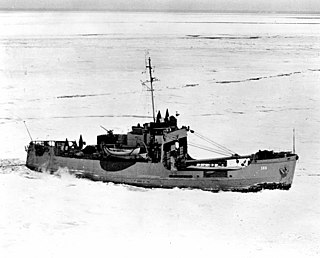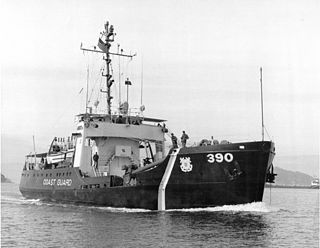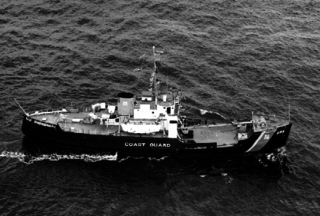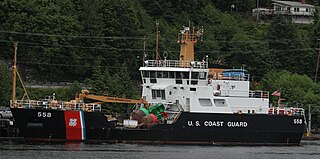
The USCG seagoing buoy tender is a type of United States Coast Guard Cutter used to service aids to navigation throughout the waters of the United States and wherever American shipping interests require. The U.S. Coast Guard has maintained a fleet of seagoing buoy tenders dating back to its origins in the U.S. Lighthouse Service (USLHS). These ships originally were designated with the hull classification symbol WAGL, but in 1965 the designation was changed to WLB, which is still used today.

USCGC Mesquite (WAGL/WLB-305) was the lead ship in the Mesquite class of seagoing buoy tenders operated by the United States Coast Guard. She served in the Pacific during World War II, and spent the rest of her Coast Guard career in the Great Lakes. She ran aground and was wrecked in December 1989 off the Keweenaw Peninsula in Lake Superior. She was scuttled nearby as a recreational diving attraction.

USCGC Balsam (WLB-62) was a Cactus-class seagoing buoy tender (WLB) in the United States Coast Guard. She operated in the Pacific Ocean during World War II, then saw service along the United States West Coast, Hawaii, and Alaska. After her decommissioning in 1975, she was repurposed as a crab catcher-processor and is active in Alaskan fisheries as F/V Baranof.
USCGC Spar (WLB-403) was a 180-foot (55 m) sea going buoy tender. An Iris class vessel, she was built by Marine Ironworks and Shipbuilding Corporation in Duluth, Minnesota. Spar's preliminary design was completed by the United States Lighthouse Service and the final design was produced by Marine Iron and Shipbuilding. On 13 September 1943 the keel was laid, she was launched on 2 November 1943 and commissioned on 12 June 1944. The original cost for the hull and machinery was $865,941.

USCGC Maple (WLB-207) is a Juniper-class seagoing buoy tender operated by the United States Coast Guard. She was based at Sitka, Alaska for 16 years and is currently homeported at Atlantic Beach, North Carolina. Her primary mission is maintaining aids to navigation, but she also supports search and rescue, law enforcement, oil spill response, and other Coast Guard missions.

USCGC Bittersweet was a C or Iris-class 180-foot buoy tender of the United States Coast Guard.

USCGC Cuyahoga (WIX-157) was an Active-class patrol boat built in 1927 which saw action in World War II. Cuyahoga sank after a night-time collision in the Chesapeake Bay while on patrol in 1978. She was later raised and re-sunk as an artificial reef off the Virginia coast and is a popular recreational dive site.

USCGC Woodrush (WLB-407) was a buoy tender that performed general aids-to-navigation (ATON), search and rescue (SAR), and icebreaking duties for the United States Coast Guard (USCG) from 1944 to 2001 from home ports of Duluth, Minnesota and Sitka, Alaska. She responded from Duluth at full speed through a gale and high seas to the scene of the SS Edmund Fitzgerald sinking in 1975. In 1980, she took part in a rescue rated in the top 10 USCG rescues when she helped to save the passengers and crew of the cruise ship Prinsendam after it caught fire in position 57°38"N 140° 25"W then while being towed sank off Graham Island, British Columbia. She was one of the first vessels to respond to the Exxon Valdez oil spill in 1989. She was decommissioned on 2 March 2001 and sold to the Republic of Ghana to serve in the Ghana Navy.
USCGC Clover WAGL/WLB/WMEC-292, a Cactus (A) Class buoy tender was built by Marine Iron and Shipbuilding, Duluth, Minnesota. Her keel was laid 3 December 1941, and she was launched 25 April 1942. She was commissioned on 8 November 1942 in the United States Coast Guard as the United States Coast Guard Cutter Clover. She was built as a WAGL, redesignated a WLB in 1965, and again redesignated a WMEC in 1979.
USCGC Tupelo WAGL/WLB-303, was a Cactus (A) Class 180-foot buoy tender vessel built by Zenith Dredge Company of Duluth, Minnesota. Her keel was laid 15 August 1942, launched 28 November 1942 and commissioned on 30 August 1943. She was built as a WAGL and redesignated a WLB in 1965.

USCGC Basswood (WLB-388) was an Iris-class buoy tender belonging to the United States Coast Guard launched on 20 May 1943, and commissioned on 12 January 1944.

The USCGC Blackhaw (WLB-390) was a Iris-class buoy tender belonging to the United States Coast Guard launched on 18 June 1943 and commissioned on 17 February 1944.

USCGC Firebush (WLB-393) was an Iris-class buoy tender belonging to the United States Coast Guard launched on 3 February 1944 and commissioned on 20 July 1944. She was eventually transferred to the Nigerian Navy in June 2003 and renamed Nwamba.

The USCGC Hornbeam (WLB-394) was an Iris-class buoy tender belonging to the United States Coast Guard launched on 14 August 1943 and commissioned on 14 April 1944.

The USCGC Iris (WLB-395) was a Iris-class buoy tender belonging to the United States Coast Guard launched on 18 May 1944 and commissioned on 11 August 1944.

The USCGC Mallow (WLB-396) was a Iris-class buoy tender belonging to the United States Coast Guard launched on 9 December 1943 and commissioned on 6 June 1944.

The USCGC Mariposa (WLB-397) was an Iris-class buoy tender belonging to the United States Coast Guard launched on 14 January 1944 and commissioned on 1 July 1944.

USCGC Anthony Petit (WLM-558) is a Keeper-class coastal buoy tender of the United States Coast Guard. Launched in 1999, she has served her entire career maintaining navigational aids in Southeast Alaska.

USCGC Ironwood (WAGL-297/WLB-297) was a Mesquite-class sea-going buoy tender operated by the United States Coast Guard. She served in World War II, the Korean War, and the Vietnam War as well as a variety of domestic missions. She currently serves as a seamanship training vessel for Job Corps.

USCGC Sedge (WAGL-402/WLB-402) was an Iris-class 180-foot seagoing buoy tender operated by the United States Coast Guard. She served in the Pacific during World War II and in Alaska during the rest of her Coast Guard career. Sedge was decommissioned in 2002 and transferred to the Nigerian Navy where she is still active as NNS Kyanwa.


















